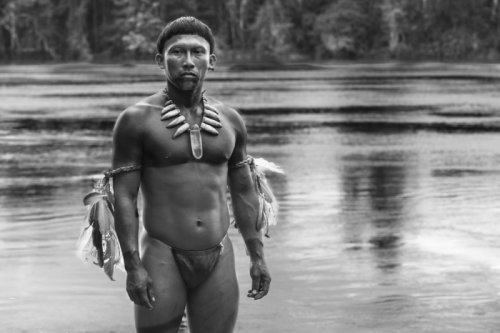Reviews - Embrace Of The Serpent
Embrace Of The Serpent
Reviewed By Stephen Pye

Embrace Of The Serpent
On Sunday evening we were treated to what must be the film of the season. Piped at the post by “Son of Saul” for this years best foreign language film at Cannes it is in many ways far superior and infinitely more mysterious.
A few minutes into Colombian director Ciro Guerra's 'Embrace of the Serpent' we have met three of its four main characters, and they have encountered each other. In black and white, period-set images of the Amazonian jungle reminiscent of Miguel Gomes' "Tabu", a canoe carrying a gravely ill white man, Theo ("Borgman" star Jan Bijvoet), is punted onto the bank by the loyal native tribesman who serves as his traveling companion. On the bank stands a lone tribal shaman, Karamakate (Nilbio Torres), whose painted face, loin cloth, feathered armbands, phallic-looking necklace and erect, impassive stance seem an unspoken rebuke to the western-clothed native who has come to plead with Karamakate to save his white friend's life. That rebuke is soon spoken, however, in no uncertain terms: Karamakate has nothing but loathing for the white man who wiped out his tribe, and nothing but contempt for a native who might abet one of their number.
But Theo, an explorer/scientist/anthropologist, offers Karamakate perhaps the only thing in all the mystical universes that might change his mind: the slender hope that members of his tribe survive and Theo knows where to find them. In a rage of confusion, Karamakate runs off and petulantly destroys the inside of his hut, before returning to the men and agreeing to nurse Theo, provided they lead him back to the remnants of his people. It is a human moment that points to the remarkable job Guerra does throughout of making the tragic, unforgettable figure of Karamakate, who is played by two different actors in the film's two different time periods, both unknowably foreign and exotic in culture, yet totally human and relatable in motivation and psychology. Just a few minutes in, the viewer is entirely submerged in this fantastical, quasi-mythical, soul-crushing yet often very funny story.
The story is set first in the early 1900s and then in the 1940s, when Karamakate (played as an older man by Antonio Bolivar) again encounters a white man seeking his help: plant enthusiast, Evan (Brionne Davis), who has read Theo's book and comes in search of the rare flower, the Yakruna, that cured him. But it's not only the infrequent shifts between the two strands that lend an unusual edge to the style. The luscious black and white photography from DP David Gallego is never just pretty, there is always something unsettling and dark lurking in its corners, a sense aided by a spectacularly evocative sound design from Carlos Garcia.
But most of all, Guerra's storytelling, inspired by the writings of two real-life pioneering Amazon explorers, on whom his two white characters are loosely based, seethes with an authenticity and immediacy that it's hard to remember many other period films achieving.
A few minutes into Colombian director Ciro Guerra's 'Embrace of the Serpent' we have met three of its four main characters, and they have encountered each other. In black and white, period-set images of the Amazonian jungle reminiscent of Miguel Gomes' "Tabu", a canoe carrying a gravely ill white man, Theo ("Borgman" star Jan Bijvoet), is punted onto the bank by the loyal native tribesman who serves as his traveling companion. On the bank stands a lone tribal shaman, Karamakate (Nilbio Torres), whose painted face, loin cloth, feathered armbands, phallic-looking necklace and erect, impassive stance seem an unspoken rebuke to the western-clothed native who has come to plead with Karamakate to save his white friend's life. That rebuke is soon spoken, however, in no uncertain terms: Karamakate has nothing but loathing for the white man who wiped out his tribe, and nothing but contempt for a native who might abet one of their number.
But Theo, an explorer/scientist/anthropologist, offers Karamakate perhaps the only thing in all the mystical universes that might change his mind: the slender hope that members of his tribe survive and Theo knows where to find them. In a rage of confusion, Karamakate runs off and petulantly destroys the inside of his hut, before returning to the men and agreeing to nurse Theo, provided they lead him back to the remnants of his people. It is a human moment that points to the remarkable job Guerra does throughout of making the tragic, unforgettable figure of Karamakate, who is played by two different actors in the film's two different time periods, both unknowably foreign and exotic in culture, yet totally human and relatable in motivation and psychology. Just a few minutes in, the viewer is entirely submerged in this fantastical, quasi-mythical, soul-crushing yet often very funny story.
The story is set first in the early 1900s and then in the 1940s, when Karamakate (played as an older man by Antonio Bolivar) again encounters a white man seeking his help: plant enthusiast, Evan (Brionne Davis), who has read Theo's book and comes in search of the rare flower, the Yakruna, that cured him. But it's not only the infrequent shifts between the two strands that lend an unusual edge to the style. The luscious black and white photography from DP David Gallego is never just pretty, there is always something unsettling and dark lurking in its corners, a sense aided by a spectacularly evocative sound design from Carlos Garcia.
But most of all, Guerra's storytelling, inspired by the writings of two real-life pioneering Amazon explorers, on whom his two white characters are loosely based, seethes with an authenticity and immediacy that it's hard to remember many other period films achieving.
Find A Film
Search over 1475 films in the Keswick Film Club archive.
Friends
KFC is friends with Caldbeck Area Film Society and Brampton Film Club and members share benefits across all organisations
Awards
Keswick Film Club won the Best New Film Society at the British Federation Of Film Societies awards in 2000.
Since then, the club has won Film Society Of The Year and awards for Best Programme four times and Best Website twice.
We have also received numerous Distinctions and Commendations in categories including marketing, programming and website.
 Talking Pictures
The KFC Newsletter
Talking Pictures
The KFC Newsletter
Links Explore the internet with Keswick Film Club


